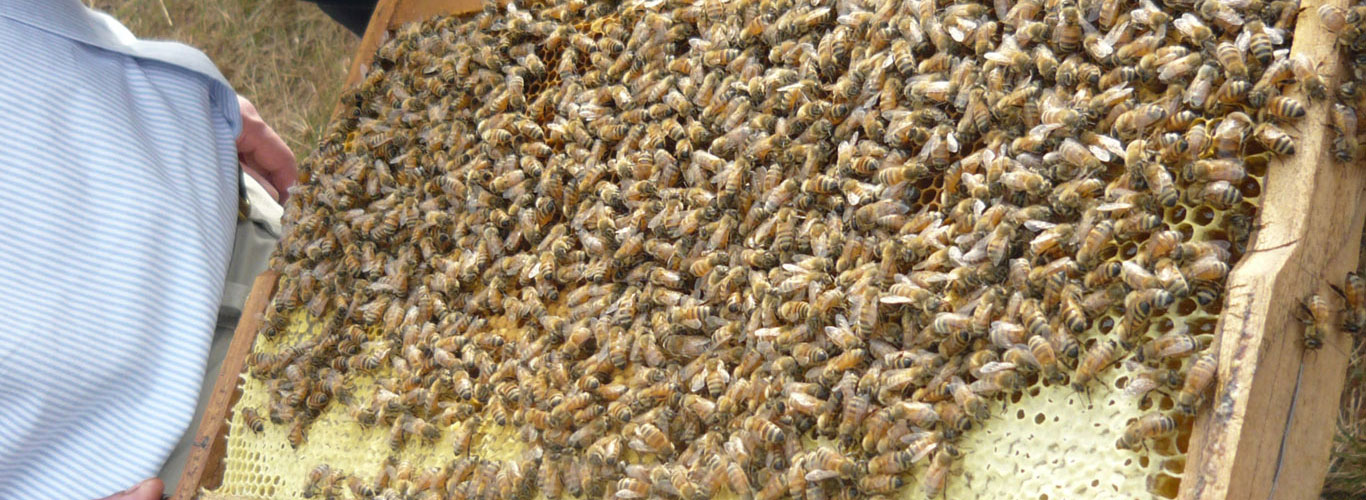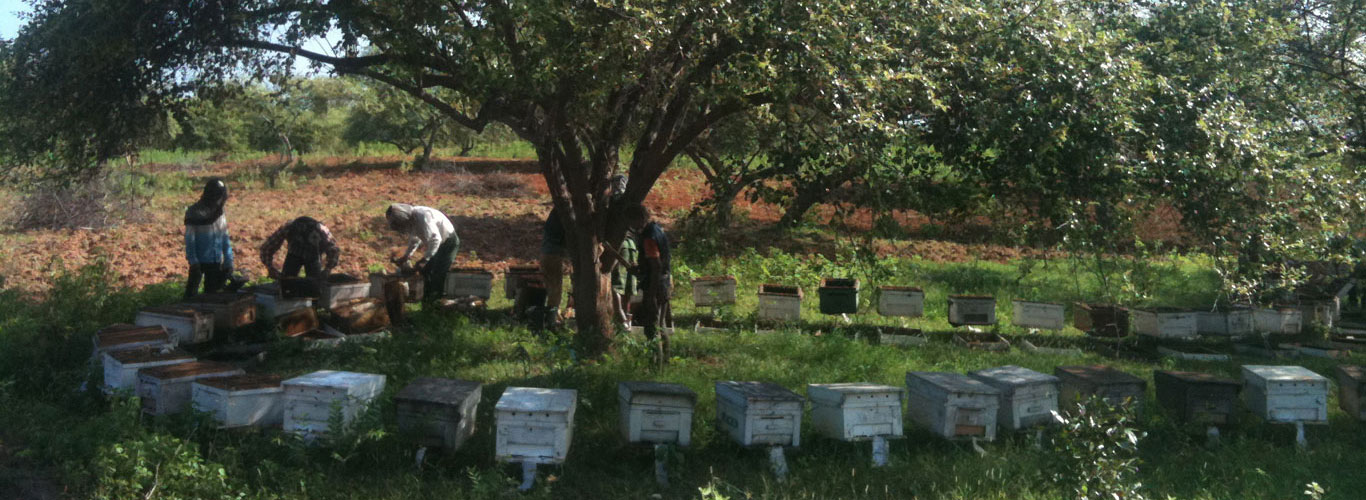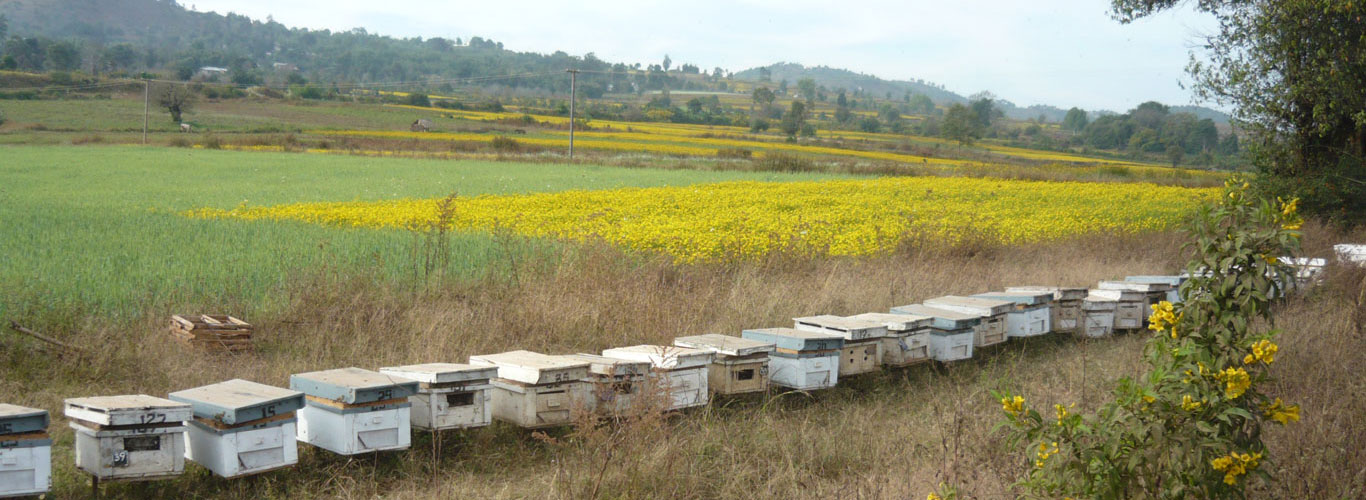International Honey Market
by RON PHIPPS
President, CPNA International Ltd.1
Co-Chairman,
Committee for the Promotion of …
Honey research breaking new ground
Research into the properties of manuka honey, renowned for its …
Honeydew Honey – More Than The Spectacular Work of Bees
New Zealand produces honeydew honey. What is it? Honey gathered …
Funding to help beekeepers rebuild after winter weather
Beekeepers in Scotland have been given financial aid to help …
International Honey Market
by RON PHIPPS
President, CPNA International Ltd.1
Co-Chairman,
Committee for the Promotion of Honey and Health
The International Honey Market is approaching a crisis due to a shortage of honey, especially genuine white honey and low priced light amber honey. The shortages and high prices of 2013 are finding more acute expression in 2014. But the shortage of honey in 2014 is also rapidly and substantially narrowing the traditional price gaps among white, extra light amber, light amber and amber honey.
Behind these shortages and escalating prices are negative climate events, especially the droughts in Argentina and Brazil. These droughts are affecting not only honey but also coffee as their impact is relatively indiscriminate. For example, Brazil’s drought has caused coffee prices to spike during the past 5 months from $1.20/lb. to $2.10/lb. The extended and persistent drought in California is contributing to rapidly increased prices for citrus fruits and nuts.
USA
According to the US Department of Agriculture, 2013 domestic honey production increased 5% from 2012, to a total over 149,000,000 pounds with 2.64 million colonies engaged in commercial production of honey.
As of mid May, there are virtually no stocks remaining in beekeepers’ hands. With prices for remaining stocks of honey having attained historically high levels of roughly $2.15/lb. for white, $2.05 for ELA and $1.95 for LA, American and Canadian beekeepers had minimal incentive to retain stocks, especially as the international shortage of honey created urgent demand among packers. As new crop honey approaches, beekeepers are talking of $2.25/lb. for new crop white and $2.15/lb. for ELA. Mono-flora honeys, which are increasingly being marketed as gourmet specialty honey, are commanding high prices. While Florida’s orange honey crop was again harmed by spraying of pesticides, California had an improved, though spotty, orange honey crop, lower in moisture and lighter in color, being offered at $2.25-$2.50/lb., depending on quality. That prices have so steadily and steeply risen reflects smaller crops than the old bumper crops of 220 million lbs., lower productivity per hive than, for example, the old 150 pounds per hive for Dakota clover crops, and increased costs of production. These factors are superimposed upon an international honey market in crisis of supply and increasingly vulnerable to dramatically increased volatility of weather patterns.
Beekeepers report that the bees coming to the Dakotas from California and the south are in excellent shape. The crop will depend the flowers which will depend upon the weather. The old adage of not selling honey until it is in the barrel still rings true.
The graph below, based upon USDA statistics, clearly illustrates price trends during the past few years. Prices of $0.98/lb. in 2007 compare to $2.10/lb. in 2013, representing an increase of over 110% during 7 years.
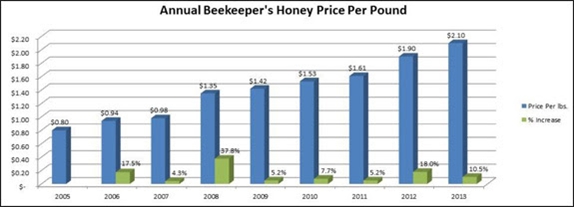
California suffered the driest year in recorded history in 2013, and conditions for 2014 are looking like more of the same (“Dry Again,” Dan White, UCSC Review, Spring 2014). In May, when moisture levels are typically high, 95% of California was in severe drought, fire warnings were in effect and fires were affecting the southern region.
Bee losses after the winter of 2014 were about 23%, showing some improvement from 2013, when they were 30% (Bloomberg News, May 15, 2014). While there are multiple variables, including migratory bee practices, mono diets, mites, and loss of natural bee habitat, negatively affecting bee health and the stress on bee populations, it is becoming increasingly clear that the widespread use of neonicotinoids on agricultural crops is a major factor. The manufacturers of these pesticides, like the manufacturers of tobacco products in an earlier era, are masters at obfuscation and denial of the harmful effects of the products from which they derive huge profits.
A recent research study reports that colonies subject to neonicotinoid pesticides had abandoned their hives – a key symptom of CCD. Neonicotinoids may cause bio-chemical impairment of honey bee neurological functions, specifically memory, cognition, or behavior. We note that 3 neonicotinoids are currently banned in the EU, but still widely used in the US, for example, on corn. While this study is not definitive, and it does not diminish the argument that a multiplicity of factors may be at play, the global significance of understanding and solving this problem, which is important to assuring the adequacy of global food supplies, is underscored.
The health of the world’s bee populations is a factor which cannot be ignored. It is only one of many factors placing increasing stress upon global agricultural production. It is not merely a question of the quantity, but also the quality of global food supplies. While pollination by honey bees accounts for 1/3 of total agricultural production, it is a much higher percentage of anti-oxidant rich, phyto-chemical foods, including almonds, oranges, apples, blueberries, cranberries, etc., which are at stake. The health of bees is inextricably integrated with the health of humanity.
The impact of last year’s major and unprecedented bankruptcy continues to unfold within the context of the international shortage of honey and escalating prices. Leading American beekeepers report that the class action suits associated with this bankruptcy continue to wind their way through the legal system, with an expanded list of defendants who are alleged to be involved in schemes of collusion to circumvent Chinese honey.
Argentina
For the second year in a row, the 4th quarters of 2012 and 2013 witnessed a speculative competitive frenzy to secure increased market share of honey. Based upon such speculation, contracts were entered for significant quantities of Argentine honey, including white honey, to be shipped in 2013 and 2014. Those shipments were often either substantially delayed, cancelled or re-negotiated, imposing upon packers of honey serious difficulties. A parallel situation exists for Brazil for both its organic and conventional honey. Market share for both retail and organic honey among packers has begun to shift as serious difficulties emerged to secure enough honey at reasonable prices to fulfill packers’ contracts with their customers whether supermarkets, discount chains or manufacturers of products incorporating honey as an important ingredient.
Currency weakness and volatility in producing countries exacerbated these difficulties. Beekeepers faced lower total production, lower productivity per hive and increased costs of maintaining healthy bees. These factors have compelled beekeepers in South America and elsewhere to demand higher prices. As currencies like the Argentine peso declined in value, Argentine beekeepers began to hold their limited honey in their hands. Producers saw both US dollar prices rising and their ability to obtain more pesos per US dollar, the longer they waited and the more the value of their currency eroded. Prying honey out of the hands of beekeepers in South America has become more difficult. Associated with the large bankruptcy in October, 2013, there remain beekeepers in Argentina who are still unpaid for 2013 honey. Caution and resolve pervade the producer communities. With real inflation in Argentina of 2.5%-3% per month, producers are holding their small stocks tightly even as prices rise. The dilemma of course is packers need something to sell and they cannot take a financial bath based upon the speculation of some importers who sold honey that was in no one’s hand, only their hope and imagination. While some speculate that an “impending de-valuation of the peso” will pry honey out of the hands of Argentine producers at low prices, we think that speculation will prove to be a fantasy.
Initially, projection of Argentina’s 2013/2014 honey crop ranged from 70,000-75,000 metric tons (154-165,000,000 lbs.). The crop coming to an end as this report is written is estimated at closer to 50,000 metric tons (110,000,000 lbs.). From January to April, 2014, 22,000 metric tons (48,500,000 pounds) were shipped to the world. Due to a cold spring, the crop began late. During Argentina’s summer there were extreme temperatures and drought in the central states of Argentina which typically account for over 50% of the total crop. In late summer to early autumn, heavy rains and cool cloudy days occurred affecting the eucalyptus and Chilean Light Amber and Amber crops.
From January to March, 2014, Argentina’s exports to the world totaled nearly $51,000,000 in value, with the USA as the major destination.
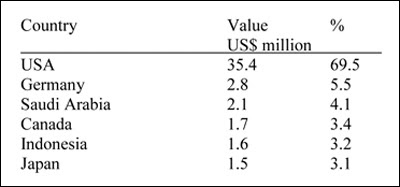
That Indonesia was the 5th ranked Argentine honey export destination may be indicative of deeper realities than appear on the surface.
Meterologists have indicated that they see signs (65% probability) of a new El Niño developing in the Pacific, as summer 2014 develops. If that comes to pass, it will undoubtedly have a significant impact upon the 2014/2015 crop.
Brazil
Brazil organic honey exports faced virtual force majeure conditions with extensive delays and non-shipments during the second half of 2013. That bitter experience, coupled with the drought of early 2014, has led to a frenzy to secure adequate supplies for the growing market for organic foods. Beekeeper prices, given heightened and pent up demand for some Brazilian honey, escalated from week to week, increasing by $.05/week.
Brazilian Honey Exports, First Quarter 2014
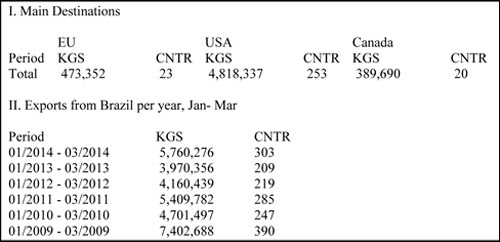
Ukraine
U.S. imports reached 2,474,068 pounds during January to March 2014. The geo-political drama in Ukraine, the major supplier of honey within Europe to the EU, has gripped the world’s attention. There do not seem to be any easy solutions without negative consequences. In 2011, total world exports from Ukraine were 9,874 metric tons (21,768,000 pounds). Ukraine has become a very important source of honey for Europe. This also means that European honey packers, fearful of both the consequence of continuing and deepening turmoil in the Ukraine, and both adulterated and ultrafiltered and “concocted” white Chinese honey, are turning to South America and doing so with a stronger Euro/US dollar ratio than many anticipated.
While the World Beekeeping Congress was being held in October, 2013, in Kiev, Ukraine, the bankruptcy of October, 2013, was an Earthquake that revealed hidden fissures and hidden relations within the American and international honey industries. The aftershocks continue.
Vietnam
Vietnam honey imports in 2013 attained a level of 74,000,000 pounds in 2013. As of March, 2014, the US has imported 19,800,000 pounds from Vietnam. Vietnamese honey that was blended with Acacia mangium, a major floral source, was darkening very rapidly, leading to color problems. The Vietnamese honey industry is working to find effective ways to select and blend honey to meet quality parameters of their export markets, including greater color stability.
Different tolerance levels for residues have made Europe an alternate destination for Vietnam. Vietnamese Light Amber honey is among the least expensive honeys in the international market. Vietnam has very diligently opposed circumvention of Chinese honey through Asian countries. The current geo-political tensions, conflicts and military skirmishes between Vietnam and China over offshore oil wells in territorial waters disputed by both Vietnam and China have attracted global concern.
India
Indian honey imports in 2013 reached about 57,000,000 pounds for the year. It is important to note that over 8,368,000 pounds of white honey were imported in 2013. Imports for 2014 have abruptly declined. There were offers floating for premium white Indian honey that may be available at $1.80/lb., far below the current price levels for US and Canadian white honey. Indian ELA and LA were quoted at $1.75/lb. and $1.65/lb., respectively.
Honey Circumvention
The problem of circumvention of Chinese honey to avoid anti-dumping duties has been dealt very serious blows and people and/or companies have been sent to jail, paid huge penalties, entered deferred prosecution agreements, been named as conspirators to circumvention, in class action lawsuits, etc. But the problem has not ceased, only the tactics have changed. In early May, honey producers from the AHPA went to Washington, D.C. and report as follows: “Commissioner Gil Kerlikowske recommitted U.S. Customs Border Patrol to …detect and eliminate the widespread, fraudulent circumvention of the antidumping duty order on honey imports from China, such as through the “Honeygate” prosecutions.” An AHPA member will serve as a representative of the U.S. honey industry on a private sector committee that advises the U.S. Customs and Border Patrol and Immigration and Customs Enforcement on international trade enforcement issues.
No one in the honey industry, or the governments of important nations, rules out the emergence of new schemes of circumvention of Chinese honey, especially white honey through old or new points of transshipment. Circumvention through over 20 nations helped create both the past disorder and the current dilemmas. Reports of dark honey being exported to third countries to add color and pollen makes the enforcement of the integrity of country of origin labeling for raw and processed honey a continual concern and challenge. As the shortage of honey extends from white to darker grades, and the price differential among different colors diminishes, the possibility of circumvention of both Extra Light Amber and Light Amber cannot be ignored.
It is also relevant to note that China is establishing Direct Outside Investment, buying factories, farms. Petroleum fields, banks and mines throughout the entire world. We cannot wisely assume circumvention has stopped for it is more likely that it is assuming new forms. Such forms involve blending honey from third countries to add color and pollen to “ultra-filtered” Chinese honey and rice syrup blends. For that reason it is important, as Prof. Vaughan Bryant points out, to establish a global data base of the pollen of the world’s honey supply.
Tolerance Levels and Testing limits
As we all know, bees are not invulnerable to diseases and honey, therefore, does not dwell in a mythical realm of ultra-purity. The need for reasonable and realistic tolerance levels and testing limits based upon ADI (average daily intake) levels is an issue about which I have written for a decade. We need to protect both human health and the health of honey bees since both are inter-related imperatives. We cannot hide behind the illusion that the lack of science based assessments of health risks and reasonable tolerance and testing limits is “your problem, not mine,” since they are our shared problems in our increasingly integrated, international honey industry.
There are now plans to discuss this issue with the FDA and seek to achieve reasonable solutions where ignorance and silence previously prevailed. The context is more favorable. The concern with the abuse of antibiotics in modern animal husbandry has intensified with genetic mutations that have led to antibiotic resistant bacteria. This reflects both less than optimum conditions for raising poultry, pigs and cattle and using antibiotics not to protect animals from disease, but to promote rapid growth of animals. If the excessive use of antibiotics on these major sources of animal protein declines, there is no valid reason to impose extremely low levels or no testing or tolerance levels, for honey, whose per capita annual consumption is about 1.1 lbs./per capita!
Can we recall the lively song from the musical Oklahoma: “Can’t the farmers and the ranchers just be friends?” We need the producers and packers, and the importers and exporters, to become more friendly. Both domestic and foreign honey will benefit from establishing and enforcing reasonable and realistic testing limits and tolerance levels. The international honey industry needs to encourage coordination among government to government regulatory agencies at point of export and import, producers and packers, exporters and importers, private and government laboratories, in order to achieve food safety, adequate supply and smoother flow of honey, and testing based upon science and authentic health risks. The National Honey Packers and Dealers Association is working to be part of this effort.
Global Climate Change
The March, 2014, UN reports on climate change have most dramatically and scientifically documented the rapid rising of global temperatures and the extent to which these are self-feeding processes which render their reality all the more serious. For example, as glaciers melt and the perma-frost retreats, light colors covering large swatches of the planet are replaced with darker colors, the former reflecting 95% of solar energy back into space and the latter absorbing solar energy and exacerbating warming processes. Similarly, the report released by NASA and the University of California, Irvine, in April 2014, indicating that “Global warming fuels loss of ice sheet in West Antarctic” bears great significance for the future of climate change and rising oceans. Once again the geo-physical processes concerned are self-feeding.
The increased volatility, severity, frequency and unpredictability of global weather patterns pose serious and negative effects upon global agricultural production.

Admiral David Titley has co-authored a report indicating that the geo-political strategic implications of climate change are becoming clearer year by year (“Climate Changes Deemed Growing Security Threat by Military Researchers,” New York Times, May 14, 2014). The National Climate Assessment, reported by Donald Wuebbles of the University of Illinois, released in May, 2014, stated: “We’re already seeing extreme weather and it’s happening now. We’re seeing more heat waves particularly in the West and in the South.”
Conclusion
Hopefully at some point these storms will pass and a more stable and vibrant honey market, based upon more creative marketing of honey, will be developed. Such a market will require 1) greater integrity without the masks of deceit that have clouded the international honey market for over a decade, and 2) creative marketing. The fundamental challenge will be how to both preserve and harmonize the incentive to produce honey with the incentive to consume honey. This effort will require the cooperative efforts of producers, packers, exporters and importers and working with governments to ensure integrity and a level playing field. Marketing Boards, like our National Honey Board, will continue to work with the industry to increase the perception among consumers of the romance, value, health benefits, quality and variety of these products which 1) arise from the interaction of bees and flowers, zoological and botanical life, and 2) play a vital role in producing the overall, diverse food supply needed to sustain and advance human civilization.
CPNA International, Ltd.
1043 Oyster Bay Road
East Norwich, NY 11732
Tel: (516) 935-3880
Fax: (516) 628-3959
e-mail: info@cpnaglobal.com
Report distributed May, 2014
Mr. Phipps is president and founder of CPNA International, Ltd. and is currently on the National Honey Board. He is an importer of honey, natural foods and tea from various international producers. Ron is also the former personal research assistant to the president of the American Philosophy Association. He is a recipient of the National Science Foundation fellowship for philosophy of theoretical physics. Mr. Phipps is a founding member of the Tea & Health Committee, which organized three major scientific symposiums on tea and health and the role of antioxidants in the prevention of disease. He has worked with FDA to develop a research protocol for the global diversity of honey. Currently, Mr. Phipps is president of the Chamber Players International.
